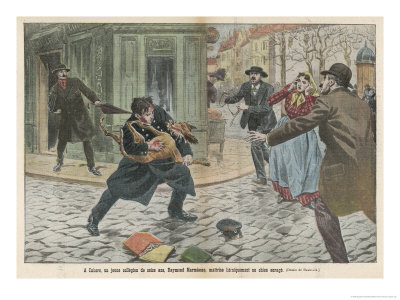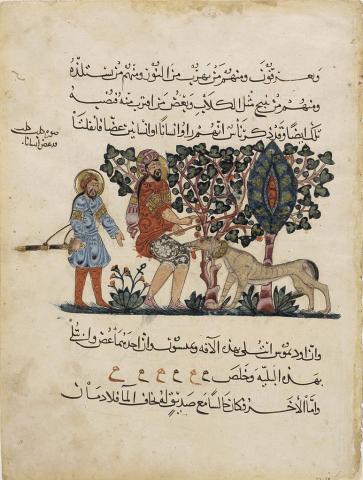-
Table of Contents
- 0. STORY PREFACE
- 1. RABIES - WHAT'S in a NAME?
- 2. RABIES in ANCIENT TIMES
- 3. WHAT IS RABIES?
- 4. LOUIS PASTEUR - EXPERIMENTER
- 5. LOUIS PASTEUR MEETS JOSEPH MEISTER
- 6. A TEEN HERO NAMED JEAN-BAPTISTE JUPILLE
- 7. LOUIS PASTEUR - WORLDWIDE BENEFACTOR
- 8. RABIES as a 21st-CENTURY PROBLEM
- 9. RABIES and ZOMBIES
This medieval illustration depicts an outdoor scene where a mad dog is biting a man; the calligrapher is Abdallah ibn al-Fadl. Created circa 1224, the illustration—an opaque watercolor, ink and gold on paper—is a folio from an Arabic translation of the Materia Medica by Pedanius Dioscorides. It is currently maintained at the Smithsonian’s Freer Gallery of Art. Click on the image for a much-larger view.
Rabies is a greatly feared disease which has afflicted mankind since ancient times.
Its very name describes the dread it inspires, not to mention the raging behavior it causes:
- Ancient Sanskrit uses “rabhas,” for rabies. It’s a word meaning “to do violence.”
- Ancient Greeks called rabies “lyssa.” That’s the same word they used for an extreme sort of murderous hate or animal rage (which seizes Hector in The Illiad and Herakles in Euripides’s tragedy of the demigod who kills his own family).
- Ancient Romans used the Latin word “rabere,” which means “to rave” (and the related Latin adjective “rabidus,” meaning “furious, raging” leads to the English word “rabid”).
- French speakers call it “La Rage.”
- English speakers use the word “rabid” to also describe wrenching agitation. The 1621 edition of the Oxford English Dictionary includes “rabid with anguish,” while the 1646 version reflects “rabid Griefe.”

And ... in ancient Mesopotamia, before Hammurabi wrote his Code of Laws ... leaders in the town of Eshnunna (located on the bank of the Diyala River, a tributary to the Tigris) issued a series of laws (known as the "Code of Eshnunna") including this one:
If a dog is mad and the authorities have brought the fact to the knowledge of its owners; if he does not keep it in, it bites a man and caused his death, then the owner shall pay two thirds of a mina (40 shekels) in silver. If it bites a slave and causes his death he shall pay fifteen shekels of silver.
The ancient words used to describe this terrible illness hold today. People who have rabies still become violently ill and, if they exhibit symptoms, they will die.
How did the ancient physicians treat people with rabies?
-
Table of Contents
- 0. STORY PREFACE
- 1. RABIES - WHAT'S in a NAME?
- 2. RABIES in ANCIENT TIMES
- 3. WHAT IS RABIES?
- 4. LOUIS PASTEUR - EXPERIMENTER
- 5. LOUIS PASTEUR MEETS JOSEPH MEISTER
- 6. A TEEN HERO NAMED JEAN-BAPTISTE JUPILLE
- 7. LOUIS PASTEUR - WORLDWIDE BENEFACTOR
- 8. RABIES as a 21st-CENTURY PROBLEM
- 9. RABIES and ZOMBIES
Media Credits
In-text image of a rabid dog, terrifying people, depicts a scene at Cahors, France where a 16-year-old boy grabs, and tries to control, the animal. The work is by Eugene Damblans (1865-1945).


 Back
Back
 Next Chapter
Next Chapter

 Back
Back
 Next Chapter
Next Chapter
